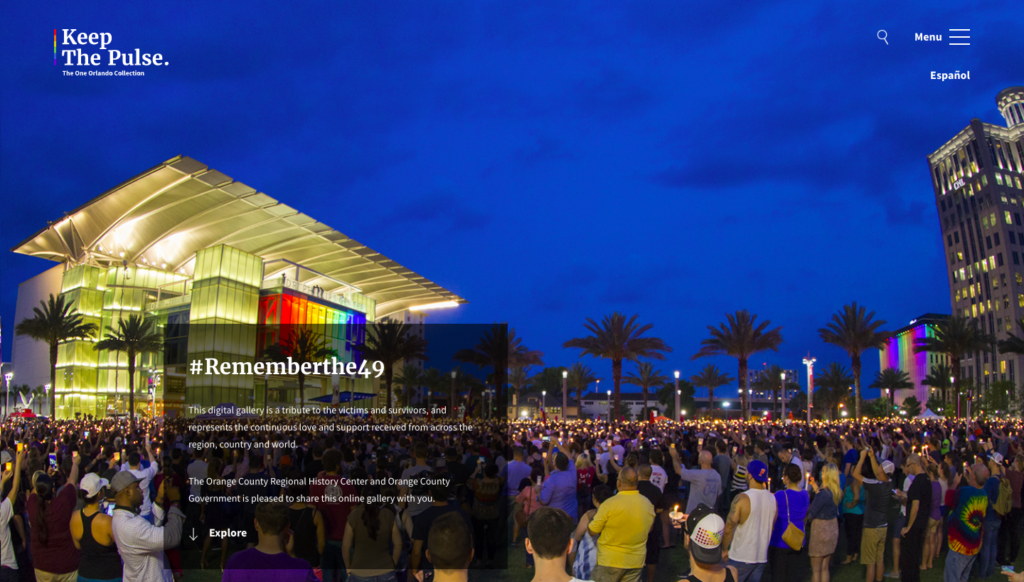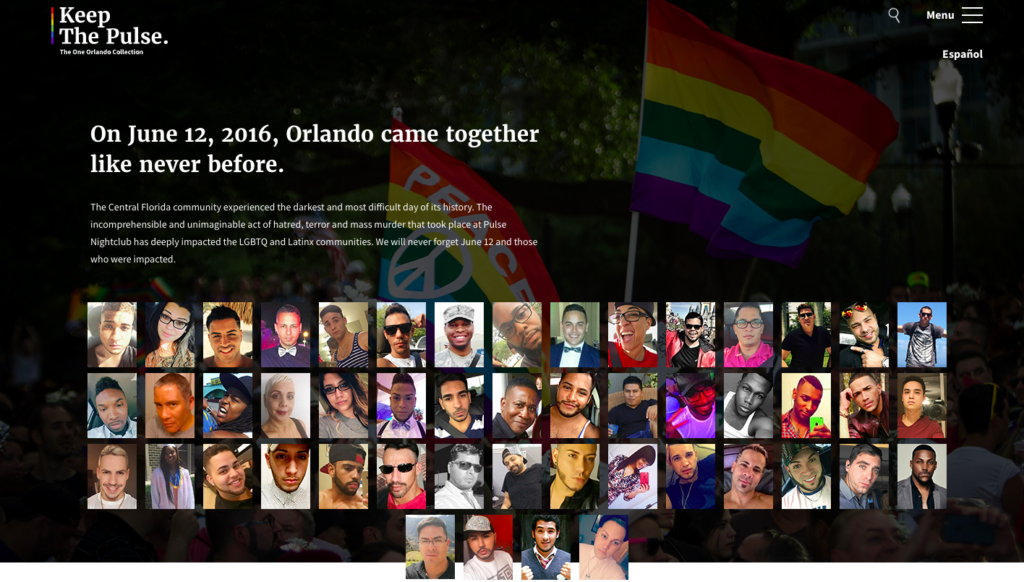Keep the Pulse. The One Orland Collection http://oneorlandocollection.com/ The Orange County Regional History Center, February 17, 2020
Keep the Pulse is a digital gallery honoring the victims and survivors of the June 12, 2016 mass murder at Pulse Nightclub in Orlando, Florida. The home page provides us with an image of a vigil with brief text describing the digital library and asking the site’s visitors to #Rememberthe49. Its imagery and sparse description is impactful, setting the tone for the rest of the website. If you scroll down, more information is provided, including the victims and their names, and access to the digital library, which commemorates the lives of the victims, as well as the LGBTQIA+ community coming together to mourn and rise up. The rest of the homepage provides information on the conservation process and how one can connect on social media, volunteer, or donate. Keep the Pulse is a heartfelt tribute to the victims and survivors of June 12, 2016 that inspires visitors to reflect and support the community of Orlando.

When arriving to the homepage of Keep the Pulse and seeing the photo of the vigil, visitors to the site will notice the care and reverence taken to make the digital gallery a place for reflection and respect. The name of the gallery is located on the top left of the homepage in white serif font with the colors of the LGBTQIA+ flag running vertically to its left side. The title is modestly sized, giving up most of the screen to the photo of the vigil outside Pulse nightclub. In a transparent text box is the headline: #Rememberthe49. Below it is a brief description of the digital gallery and the curators. Giving the photograph of the vigil space provides visitors with a moment of reflection, as well as setting the tone for the rest of the site. On the top right of the screen is the menu bar. Right below it is the option to view the sight in Spanish. The Spanish option is an important act of inclusivity. Most of the victims of June 12 were Latinx, making the incident one that affected both the Latinx and LGBTQIA+ communities and all the intersectionalities in between. Scrolling down, the site provides access to the digital library and images of the 49 victims.

Scrolling down the page, the digital library provides images of the 49 victims. The highlighted image provides the name of the victim. It is here that I have my only critique of the website. I wish there were a brief bio about the victim or anecdotes written by found or biological families. I would also prefer that each image provide links to other artifacts in the digital library that are connected to the specific victim. There are several links that provide access to the digital gallery, where one can view all the artifacts or filter by category or by victim. I like the options for filtering, but people who aren’t part of the queer Orlando community may not know the victims personally. The filtering option only provides names. I would suggest providing images as well. Providing a face to the name when looking through the artifacts would humanize the experience further. After looking through the gallery, there are links that provide further information on the project, or next steps visitors would want to take.
Visitors to the Keep the Pulse digital gallery have the option to take further actions after reflecting on the events of June 12, 2016. For further information on the website’s construction, the Orange County Regional History Center provides a summation of how the gallery came to be. There isn’t a page about their ethical approach, which I feel is missing, but the site does contact information in case visitors have further questions. The digital gallery also invites people to share their reflections on social media with #Rememberthe49. The site provides suggestions, events, general information about nonprofits, and frequently asked questions. The people behind the site have considered various site visitors and provide information that will help people contribute as much, or as little, as they can.
Keep the Pulse has remained active and it appears it will continue to be active as we enter the fourth anniversary of the tragedy at Pulse Nightclub. This digital history is preserving the events of June 12th so that it won’t be soon forgotten. The site is easily navigable and provides a sense of reflection and reverence that the victims deserve. Visitors to the site can honor the victims by looking through the gallery, or taking further action, depending on their resources. The site stresses acts of love and kindness, and this digital gallery is emblematic of that notion.
